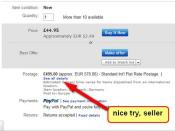Section A: Problem/Issue Statement
Following a 220% increase in profits and 800% increase in revenues over six months, eBay Inc. is considering the following courses of action:
1.One being an IPO offering, requiring the sale of less than 9% of the company. This offering will be for 3.5 million shares, with an expected sale price at between $14 and $18 per share.
2.The other is to delay the offering for six months. This will cost eBay approximately $1 million in direct expenses; however eBay's additional losses will be far greater due to the delay of major investment initiatives.
In determining the appropriate course of action, the following topics were considered:
1. What are the costs and benefits of eBay going public?
*How do current market conditions affect the decision to go public?
*What are the advantages and disadvantages of delaying the IPO versus proceeding now?
2. What is the appropriate IPO price?
*What is the intrinsic value of eBay?
*What drives IPO price besides intrinsic value?
*How do the various "stakeholders" view pricing:
oShareholders (current and IPO purchasers)?
oCompany?
oManagement?
oEmployees?
oInvestment Bankers?
oCompetition?
Section B: Recommendation
We recommend that eBay should go ahead with the IPO offering.
*We feel that the company is in a good situation right now to offer the IPO.
oAlthough other companies have been reluctant to issue and IPO in the past weeks, we feel that eBay's situation is different.
oWe can be the IPO that will heat up the market again.
*The share price that we have decided at, we feel is a reasonable price for the potential value of the company.
oSince we valued our company and we can receive the price that we want right now there is really no reason why we should wait for six months.
After reviewing the plans to delay the IPO, we decided it was not in the best interest of eBay's stakeholders.
*The market may likely be worse off in six months, and in that case we will receive a price lower than what we can now.
*We will incur costs of over $1 million, which we feel is unnecessary because the market currently is relatively not performing too unfavorably.
Overall, we feel that going public right now is an appropriate time for eBay because eBay is a company that investors will be enthusiastic about the value in during a time when most investments appear to be high risk.
Section C: Case Background
In relating the IPO process to eBay's IPO situation, we made the following assumptions and observations:
1.The timing of an IPO can very well determine how much capital a company can raise. This timing relates both to market conditions and the current performance of the company.
*Investor enthusiasm for IPO's run in hot and cold cycles.
a.Favorable economic conditions positively impact the cash flows of both publicly traded and privately held firms.
b.Waves of IPO's occur when the cash flows of both the issuing firms and publicly traded companies are high.
i.IPO waves coincide with times of relatively high share prices.
ii.We currently do not observe any sign of an IPO wave, as there has only been one IPO issuing over the previous two straight weeks, the longest stretch in 7 years.
*Currently, the market is becoming increasingly volatile.
a.The issue price may be lower than if it were issued in a more stable market.
*Currently, eBay is showing positive earnings, while most other internet companies are not even close to being capable of.
a.The issue price may be higher now because of eBay's impressive performance.
b.It is hard to compare eBay to the internet stock index (ISDEX) because they have already proven themselves in the market place.
2.In relation to underpricing and underperformance, neither eBay nor the investment bankers want to leave a substantial amount of money on the table, although it is expected that we should plan to leave some margin of error in order to be on the conservative side.
i.eBay does not want to overprice their IPO, thus underperforming, which would result in the stock price sinking.
3.We came across the issue in valuing eBay's IPO of the realization that it is always difficult to value a new and growing firm.
*eBay's positive earnings fix this issue because they prove that eBay is already far ahead of the game.
4.We determined an appropriate WACC to be 16% and an appropriate terminal growth rate to be 6%. (Exhibit 1)
We used the following approach for our valuation of eBay:
*The discounted cash flow approach, in which we used the following strategies:
oNon constant growth free cash flow model.
oEstimating the free cash flow.
oEstimating the discount rate.
oEstimating the terminal/horizon value.
Section D: Analysis
Part I: Quantitative Analysis
We found the appropriate IPO price, if issued today, to be around $17.
*This will make the intrinsic value of eBay about $59.5 million, should eBay decide to issue the 3.5 million shares. This $59.5 million will be very beneficial for eBay's future growth. (Exhibit 2)
*This will value the current owners' holdings at nearly $616 million, which is on the higher side of Goldman's recommendation. (Exhibit 2)
*We calculated the cash flows of the firm and discounted them by our WACC, which was roughly 16%. We used a terminal growth rate of 6% (Exhibit 1)
Part II: Qualitative Analysis
With going ahead with the IPO issue, we found that it will have the following impacts on the areas we found relevant to our analysis.
The benefits of eBay going public include:
1.It will give the current eBay shareholders more liquidity.
2.There will be more opportunities for mergers and acquisitions because additional stock can be issued as part of the agreement.
3.Public companies are seen as more encouraging by lenders. If eBay were to decide to issue debt in the future, it will get more favorable interest rates.
4.eBay will have the opportunity to use the additional capital towards debt buy down.
5.The ability to raise capital in the future will be considerably easier after the first public offering.
6.eBay will have growth opportunities that it probably would never have the chance to reach with out the additional capital.
7.With public ownership, there is better monitoring of corporate performance because of incentives to please shareholders.
8.eBay can put into practice employee stock ownership plans, thus drawing talented and motivated employees.
9.The prestige of being a publicly traded company on a major stock exchange.
The costs of eBay going public include:
1.There are high fees paid to investment bankers. These fees for eBay are going to be around 7%, which comes to around 5 million dollars. This money could be used for investment activities.
2.The risk of a severe stock price drop after the offering could put the company in financial distress.
3.SEC filing costs and legal fees will be incurred.
4.An average IPO reflects 12% underpricing.
5.There are indirect costs of managerial time.
The current market conditions had the following effects on our decision to go public:
1.The market is currently becoming increasingly volatile which means that the issuing price may be lower than if it were issued in a more stable market.
2.The market is currently declining, however we have no way to be assured that it will not continue to decline, making this possibly a relatively attractive market.
The advantages of delaying the IPO include:
1.It may prove worthwhile for eBay to wait it out until a favorable IPO cycle occurs.
2.We will avoid the risks associated with being the first company to issue an IPO after the slowest month since the 1970's.
The disadvantages of delaying the IPO include:
1.Although there volatility exists, the market is still doing relatively well, and if eBay were to wait, they run the risk of the market declining even more, possibly even going into a deep recession. In this case, eBay will have missed out on the opportunity to raise capital.
2.If we go ahead with the IPO, we will signal that we are confident our stock is valuable despite the declining market.
3.Delaying the IPO will cost eBay $1 million in direct expenses. We are already far enough in the underwriting process that it may be wise to continue on.
4.The demand for eBay's stock has been high from investors at road shows. This is a sign to us that our IPO will perform well.
5.After a series of strong quarterly financial reports, eBay looks very appealing to investors. This may be the best time for eBay to go public.
We have researched the following stakeholders and determined how they will view the pricing of eBay's IPO.
1.eBay's shareholders will prefer the highest price possible because it will make their current earnings worth a great deal.
2.The company will benefit from as high of a price it can get in order to raise the most capital possible to fund future growth.
3.Management will want a high price to signal firm strength, although they will prefer to stay on the conservative side in order to maintain the price.
4.Employees will want a high price because they will benefit from a growing company.
5.In this case, investment bankers will prefer that the price best reflects the market because they have agreed to a firm commitment underwriting. This will guarantee them the sale of all shares.
6.The competition will generally want a low price to keep eBay from raising capital to gain market share.



EBay Case Study
I would like to view the exhibits quoted in this essay. Is this possible.
sbechler@cox.net
6 out of 6 people found this comment useful.